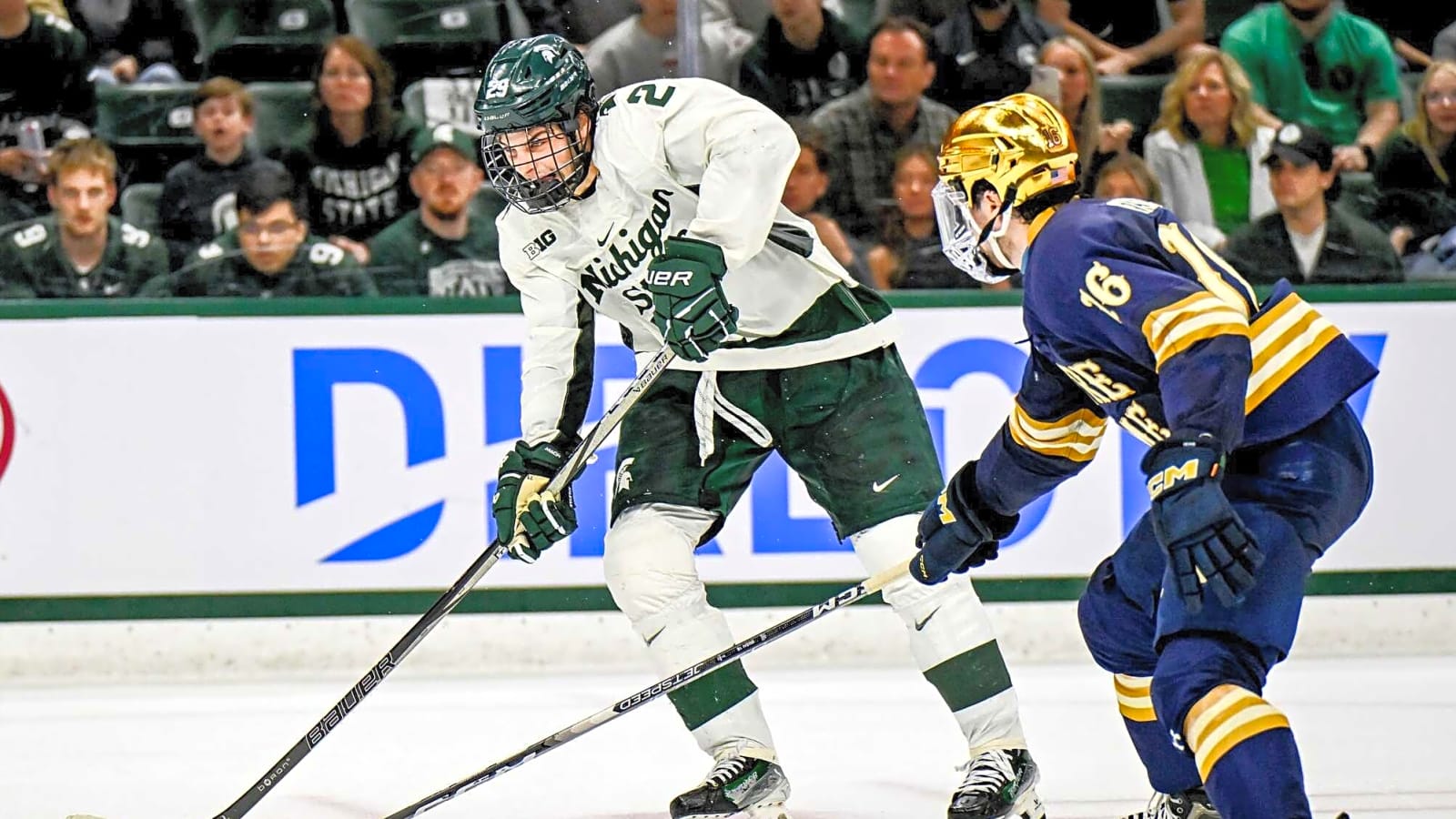
Welcome to The Oil Rig Edmonton Oilers Prospect Rankings for the 2025 offseason. In the #10 spot we find the NCAA defender Paul Fischer. Fischer was acquired by Edmonton in August of 2024 as part of the St. Louis Blues offer sheets, so he was not in consideration last year.
| Position | Year Drafted | Highest Ranking | Lowest Ranking | 2024 Ranking |
|---|---|---|---|---|
| Left defence | 2023, 5th rd, 138th Overall | 8th | Unranked | N/A |
Fischer’s development so far
Fischer is a product of River Forest, Illinois, and grew up in the Chicago Mission minor hockey. The 6’0” defender represented Chicago Mission at the U13, U14, and U15 levels. Come the 2021–22 season Fischer made the move to the US National Team development program.
There he played plenty of hockey with their NTDP, and USHL teams for the following three seasons with their U17 and U18 teams. This play, particularly his play as a defensive orientated shutdown defender made him jump on the radar of NHL scouts.
After his solid 2022–23 season, this interest came to fruitition when he was selected in the 5th round of the 2023 draft, originally by the St. Louis Blues. Committed to the NCAA route, the fifth rounder then made the jump to the NCAA with the University of Notre Dame.
In his freshman season with Notre Dame Fischer played a capable third pairing shut down role, where he averaged 18:18 a night as a true freshman. That TOI and responsibility then jumped in his sophomore season where he proved his worth as a defensive defender with increased offensive growth as well.
| Season | Team | League | Games Played | Goals | Assists | Points |
|---|---|---|---|---|---|---|
| 2022-23 | USNTDP Juniors | USHL | 22 | 2 | 4 | 6 |
| 2022-23 | US U18 National Team | NTDP | 56 | 4 | 17 | 21 |
| 2022–2023 | USA U18 | WJC-18 | 7 | 0 | 1 | 1 |
| 2023-24 | University of Notre Dame | NCAA | 34 | 2 | 14 | 16 |
| 2024-25 | University of Notre Dame | NCAA | 36 | 2 | 19 | 21 |
| 2024-2025 | USA U20 | WJC | 2 | 0 | 1 | 1 |
This past season Fischer displayed the ability to find the scoresheet more as a set up man, while being a reliable trustworthy defender in his own zone as well. This past season he averaged 21:41 of TOI with 26 shifts per game. Fischer played an active role on both of Notre Dame’s power play and penalty kill.
Fischer’s strengths
Fischer is a stable transitional defender with defensive upside. The fifth rounders game is highlighted by decent defensive senses, noticeable physicality, and some flashes of facilitator puck skills.
Physicality
Fischer is not scared of the grittier game thats for certain. His physicality is highlighted by hit effecientcy/effectiveness, quality body positioning, and hit absorption.
Physicality plays a large role in his gap control as he netrualizes opponents speed with physical play disruption and physical pressure, often pushing and pinching opponents to outside lanes or straight into the boards.
This shows two things: no physical avoidance from the defender and reduced risk from zone entries against.
Even in board play, Fischer demonstrates good inside body positioning through solid hit absorption, balance, and body leverage that is articulated through a hip-hold play in such instances. These board play tactics reduces the pace of play and allows his forwards to come and strip pucks with efficiency.
The American also engages in a significant amount of board battles at 10 per game, and still maintains a winning percentage of 53%. This hit absoption is also evident statistically as Fischer is on the recieving end of 1.74 hits against per game.
Taking so much of this punishment also shows that the college sophomore has decent muscle mass, grit, and aggressiveness in slot-based plays as he forces his will onto opponents through tie ups and stick lifts and blocks 1.8 shots per game.
When he wants to be Fischer is a tough defender to play against.
Defensive senses
These defensive senses are best exemplified by his risk mitigation, physical pressure, and play disruption both in transition and zone play. The 20-year-old defender starts 68% of all of his shifts in the defensive zone, which should be a clear indicator of his defensive ability.
In gap control Fischer plays with quality pace, and despite skating limitations the American shows a higher quality ability to disrupt opponent breakouts and zone entries with the way he demonstrates lane control by keeping opponents to the outside, while showing a good active stick, and proactive scans.
Fischer is a rush neutralizer, which limits the speed and effectiveness of opponents transition game, and shows higher end defensive instincts. Its in this rush neutralization via proactive scans especially on retrevials that Fischer is able to generate nine take aways per game compared to his 5.9 giveaways.
These proactive scans particularly allow Fischer to display some play anticipation and as a result he knows where the risk, pressure, and opponent opportunities will come from. This hints at above average defensive timing, play anticipation and defensive responsibility.
His positioning shows some mixed results in zone play, especially off of faceoffs as he has a slight tendency to jump a bit too high in read and react positioning.
Overall though the 6’0” defender shows good defensive instincts, with defensive and physical pressure exertion that blends seemlessly with stick tie ups, boxouts, and quality lane awareness. This defensive aptitude is best exemplified by his 1:49 of penalty kill time and 0.11 scoring chances saved per game.
Fischer also shows an around average compete level with his physicality through a okay motor, intensity, and some flashes of hustle.
As the defender matures expect his defensive poise and instincts to improve and add further layers to them.
Puck skills
Puck skills is an area that Fischer has shown notable growth in this past season. What particularly shines is the defenders ability to generate breakouts, quality vision, and control.
The fifth rounder has 105 puck touches per game, and from that implements 29 passes in that span with a notable 90% accuracy.
In these puck touches Fischer demonstrates good puck control, option ID, and vision to implement quick and effective breakouts for supporting forwards. On average, the defender initiates 5.3 breakouts a game, which shows a good level confidence, handling, and decision making.
This quick decision making allows his teammates to generate even quicker offensive pressure generation in transition and form effective rush attacks.
Fischer’s handling shows the best results as a touch and go facilitator. This facilitation is complimented by some decent lane awareness and vision, which explains his role as a power play quarterback and his 2:47 of power play time per game to go along with his season high 19 assists.
By itself his puck skills are decent enough, but Fischer struggles with over-handling pucks, being over ambitious with his breakouts resulting in passes into pressure, and pass placement at points.
Fischer’s areas of growth
Fischer also shows some notable limitations in his game. These limitations include his less than ideal skating, and being almost a non-factor in offensive play.
Skating
Fundamentally Fischer’s ankle flection, and posture are about average, its in the mechanics of his skating where the real issues lie.
The former WJC defender’s skating is hampered by poor depth, slight ineffecientcies in his stride recovery, and extension length. All of which reduce his overall power and as a result limit his acceleration, gliding, and top speed.
There are also fundamental issues with his mobility too as his edgework and agility are below average, which is best exemplified by his space management in his gap control through his early pivots.
To compensate Fischer creates shorter routes to the net, or smartly angles himself which works at the NCAA level, but the transferability of this to the professional ranks will expose him to some challenges in transition play. This also explains the limited effectiveness of his activations in offensive play as well.
These shortcomings make pace based deception, (ie lane manipulation, or defender manipulation), harder to implement.
Shooting/offensive play
Fischer shows some red flags in his offensive zone play as he struggles with offensive instincts, awareness, and play reading. In short he does not contribute much in terms of offensive off-puck play, largely serving as a blue line support element shooting pucks deep and blue line shots.
These limitations in offensive instincts show little play driving, offensive creativity, or offensive poise.
This mixed with shortcomings in offensive awareness results in 0.31 scoring chances per game, but a 18% conversion rate which displays some finishing, but also could be a red flag for offensive regression next season.
The defender often looks quite passive and static in offensive zone play, when he’s not on the man-advantage, and when he does not have the puck.
Shooting wise Fischer takes 4.2 shots a game, but only has a 44% accuracy of even hitting the net. A large portion of the reasoning for this is below average shot lane recognition, as the Illinois product often resorts to odd-angle shots and low risk shots that have lots of bodies in front of him.
This poorer shot selection relates back to his limitations in terms of offensive instincts and awareness.
Mechanically his shooting form looks quite stiff with a shovel shot type of release that displays below average arm push out, limited leverage, which combine to reduce the power and accuracy of the shot. The release point itself is like a push which makes it straightforward and limits its deception.
One thing of note is that at the next level, be it AHL or NHL, Fischer won’t be relied on to be a dynamic offensive point getting defenceman, as that wont be his type of game.
Fischer’s next steps
Expect Fischer to complete his schooling and his hockey development with Notre Dame first. This means at minimum two more seasons within the NCAA to better round out his skillset and make him a more competitive and well rounded player.
This timeline also shows plenty of room for refinement in his puck management, skating, and shooting. The correction of these along with his offensive senses would ideally be fixed at the NCAA level, before he makes that jump to the pro-ranks and possibly gets stuck in old habits.
If this season is any indication he has the potential for more growth, as these improvements to his offensive touch show some promise and ideally this is an indication that his growth is just scratching the surface.
NHL ETA: four to five years
NHL potential: Likely a bottom pairing transitional defender with defensive qualities
What do you think of Paul Fischer? Where would you have ranked him on the Oilers prospect pipeline?
More must-reads:
- Maple Leafs get boost for the long term with latest roster news
- Does Cowboys acquiring Quinnen Williams make amends for Micah Parsons trade?
- The 'World Series MVPs' quiz
Breaking News
Trending News
Customize Your Newsletter
 +
+
Get the latest news and rumors, customized to your favorite sports and teams. Emailed daily. Always free!








